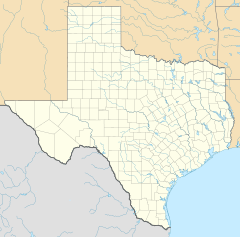Cross Roads, Henderson County, Texas facts for kids
Quick facts for kids
Cross Roads,
Henderson County, Texas |
|
|---|---|
| Country | United States |
| State | Texas |
| County | Henderson |
| Time zone | UTC-6 (Central (CST)) |
| • Summer (DST) | UTC-5 (CDT) |
Cross Roads is a small community in Henderson County, Texas, in the United States. It is an "unincorporated community." This means it does not have its own local government like a city or town. Instead, it is part of the larger county.
Contents
History of Cross Roads
Cross Roads is located where two important roads meet. These are Farm Road 59 and Farm Road 3441. The community is in the southwestern part of Henderson County.
Early Beginnings
The area was first settled in 1846. Reverend Hezekiah Mitcham and his wife, Mary Clarke Mitcham, moved here from Alabama. The very first settlement was called Science Hill.
Later, in 1885, a post office opened. It was named Wildcat. George B. Thompson was the first postmaster. By 1892, the community was growing. It had three cotton gins and a general store. However, the Wildcat post office closed in 1905.
The community was also known as Thompson's Mill. This name came from a water-powered mill. D. M. Thompson built this mill in 1871 on Wildcat Creek.
How Cross Roads Got Its Name
The name "Cross Roads" started in the early 1890s. A group of Baptists held a special outdoor meeting. This meeting took place where two roads crossed. One road went from Athens to Wildcat Ferry. The other went from Malakoff to Palestine. This intersection gave the place its name.
The first permanent building in the area was a church. It was built after a school, called Union-Center, moved to this location.
Schools and Growth
In 1908, a one-room schoolhouse was built. Sam Holland taught there. He later became a judge in Henderson County. In the early 1900s, Cross Roads was a busy farming community. It had many businesses. These included cotton gins and gristmills. There was even a post office until World War I. A courthouse was also built for local legal matters.
In the mid-1920s, several smaller schools joined together. This created the Cross Roads Consolidated School. The school grew and improved over the years. The WPA helped make upgrades. In the late 1940s, the Cross Roads Independent School District was formed. This district brought together eight smaller school areas.
A fire in 1953 damaged much of the school. Most of it was rebuilt. However, the high school closed. Students had to go to nearby districts for their high school education. In the late 1970s, the district began adding high school grades again. By 1980, Cross Roads had its first high school graduating class since 1953.
Economy and Population
Farming was very important in Cross Roads. People grew cotton and raised cattle. Other crops and fruits were also grown. In the 1940s and 1950s, oil and gas were discovered. This brought a short period of growth to the area. The population of Cross Roads was reported as 135 people in 1988, 1990, and 2000.



